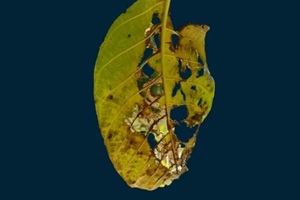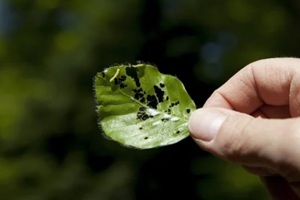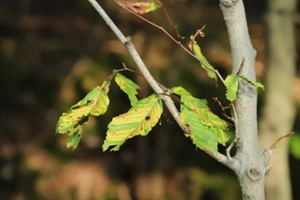
Beech trees have long been treasured for their beautiful foliage and ecological value, but a devastating new threat has emerged across the Eastern United States. Beech leaf disease (BLD) leads to dieback in American beech trees, with initial symptoms manifesting as dark stripes appearing between the lateral veins of leaves during the spring.
Since its first identification in Ohio in 2012, this disease has rapidly spread throughout the northeastern and midwestern states, now affecting beech trees in Virginia and surrounding areas.
For Virginia homeowners with beech trees, knowing how to identify and address this emerging disease can be the difference between preserving these valuable landscape assets and watching them decline. This article will help you identify the early signs of beech leaf disease in your trees and explain how to treat it.
What Causes Beech Leaf Disease?
BLD is caused by an invasive nematode, Litylenchus crenatae subsp. mccannii, which is a microscopic roundworm. Unlike many tree diseases that affect roots or bark, this nematode specifically targets leaf tissue, with primary damage occurring in the bud stage before leaves emerge.
During winter, these microscopic pests overwinter in developing buds, feeding and altering plant cell structure. This feeding activity creates the characteristic symptoms that become visible when leaves emerge in spring.
Early Signs: How to Identify Beech Leaf Disease
Recognizing beech leaf disease early gives you the best chance of successful intervention.
Primary Symptoms
Early BLD symptoms include dark stripes between the veins on leaves; you might also notice dark green bands on the underside of leaves. These dark interveinal bands appear as opaque striping that runs parallel to leaf veins, creating a distinctive pattern unlike other tree problems.
- Leaves develop a thick, leathery texture instead of their normal papery feel
- Foliage appears cupped, deformed, or shriveled
- Leaves may be noticeably smaller than usual
- Premature leaf drop occurs, along with aborted buds, leading to sparse leaf cover
- The overall canopy becomes thin and sparse
Advanced Disease Indicators
In severe cases, you may observe branch dieback starting from the tips, reduced leaf and bud production throughout the tree, overall decline in tree vigor and health, and increased susceptibility to other pests and diseases.
What Beech Leaf Disease Is NOT

Several conditions can cause similar symptoms, making accurate identification important. Woolly beech aphids cause leaf deformation, but leaves are often rolled or curled without banding between veins.
Erineum gall creates interveinal damage but produces white to red velvety patches on leaf undersides rather than dark banding. Beech anthracnose creates round lesions with yellow halos rather than characteristic dark bands.
Treatment Options for Beech Leaf Disease
While there’s currently no cure for beech leaf disease, several treatment approaches have shown promise in managing symptoms and extending tree life.
Certified arborists apply targeted treatments that strengthen your tree’s natural defenses and reduce nematode activity using safe, professional-grade products tailored to your tree’s size and condition.
Pruning in winter or early spring can also help reduce moisture retention in leaves, creating conditions that are less favorable for nematode survival and spread.
The Importance of Professional Assessment and Treatment
Professional arborist involvement is essential for BLD management. Certified arborists are trained to spot leading indicators and symptoms of BLD early, as well as create treatment plans tailored to the needs of your tree.
As with any treatments involving chemicals, it is critical that the application is executed by a professional.
Long-term Outlook and Tree Preservation
Young trees often die within one year of infection, and mortality for mature trees is estimated between 6 and 10 years. However, with proper treatment, many trees can maintain functional canopy coverage and continue providing landscape value. Timely identification and swift professional treatment provide the best chances for long-term survival.
Environmental Considerations
Beech trees play important ecological roles in the landscapes of Virginia, providing food for wildlife through their nuts and creating nesting cavities for various bird species. They contribute to forest diversity and serve as important components of mature hardwood ecosystems.
Preserving healthy beech trees supports local wildlife populations and maintains ecological integrity. Additionally, mature beech trees represent significant landscape investments that contribute substantially to property values.
Trust RTEC Treecare for Professional Beech Leaf Disease Management

Protecting your beech trees from this emerging threat requires the expertise and resources that only a professional arborist can provide. RTEC Treecare merges deep expertise in tree diseases with a variety of the most effective treatment options available.
Our ISA-certified arborists stay current with the latest research on beech leaf disease management and can develop customized treatment plans based on the specific needs of your trees and your property’s unique conditions. We understand that every tree represents both an environmental asset and a financial investment worth protecting.
Don’t wait until symptoms become severe. Call RTEC Treecare at (571) 506-6140 or contact us online to schedule a professional assessment of your beech trees and discuss proactive management options that can help preserve these valuable landscape assets for years to come.


